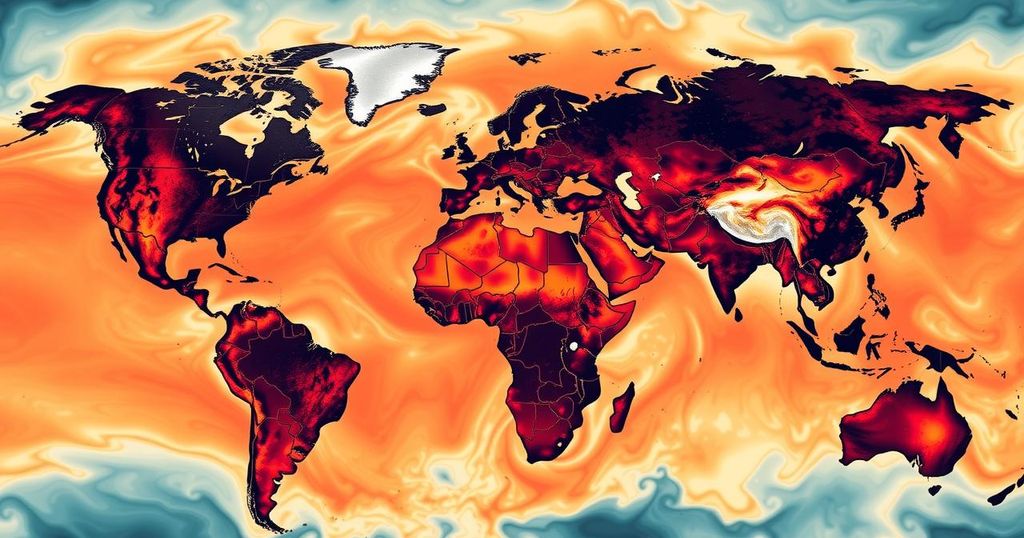The year 2024 was marked by new record-high global average temperatures, surpassing the 1.5°C threshold for the first time, according to the EU’s Copernicus Climate Change Service. This year experienced extreme weather events, including catastrophic flooding in South Asia and severe droughts in the Amazon. Although the Paris Agreement aims to limit warming, the non-linear relationship between global and regional weather patterns means every small increase in temperature carries significant risks, particularly in vulnerable areas.
The year 2024 marked a critical and alarming milestone for global climate, as reported by the EU’s Copernicus Climate Change Service. It was the first year on record where the global average temperature surpassed the significant threshold of 1.5°C above pre-industrial levels. This alarming rise was accompanied by extreme weather events worldwide, including devastating flooding in Pakistan and Afghanistan, severe droughts affecting Amazon river levels, and dangerous heat waves in Greece, leading to the closure of the ancient Acropolis for public safety. Notably, most regions across all continents, excluding Australasia and Antarctica, experienced their hottest temperatures recorded in history, with measurable impacts on public health and safety.
Climate scientists utilized a method known as reanalysis, integrating various observational sources to offer a comprehensive view of temperature changes and weather extremes. This tool is essential for studying weather patterns and climate trends globally. The findings reinforce the urgent need for action, as per the Paris Agreement, where countries are committed to limiting global warming to below 1.5°C. Unfortunately, while this year exceeded the threshold, it does not imply a permanent breach of the Paris Agreement criteria, which focuses on long-term average temperatures. The current long-term average stands at approximately 1.3°C.
Despite significant fluctuations in yearly temperatures, natural factors such as El Niño have exacerbated the observed rise in global temperatures for 2024. While El Niño typically results in higher temperatures, its impact can also cool the earth in subsequent years, highlighting the complexity of climate dynamics. It is critical to recognize that even transient climate changes can have severe impacts, such as increased risks of catastrophic phenomena like the melting of the Greenland ice sheet.
The report reveals that, on July 10, 2024, approximately 44% of the world faced heightened heat stress, with particularly dire consequences in low-income nations. In addition, atmospheric moisture content rose by 5%, contributing to more severe rainfall events. The increase in moisture in conjunction with changing wind patterns intensifies weather events, further stressing regions already vulnerable to climate extremes. To avoid surpassing the 1.5°C limit for extended periods and mitigate the detrimental effects of climate change, swift action to reduce greenhouse gas emissions is of paramount importance. Alongside this, infrastructure must be adapted to withstand the unprecedented weather extremes caused by current and future warming levels.
Looking ahead, there is uncertainty regarding whether 2025 will continue the trend of rising temperatures seen in 2024; however, the unprecedented record serves as a critical reminder of the profound influence of human activity on climate change. It highlights a pressing need for a global reassessment of climate policies and behaviors to ensure a sustainable future.
The report issued by the EU’s Copernicus Climate Change Service serves as a crucial document in understanding the accelerating crises posed by climate change. It discusses the various impacts related to rising global temperatures, noting that we reached a new threshold of 1.5°C above pre-industrial levels in 2024. The complexities of climate behavior and extreme weather events are emphasized, outlined by recent natural disasters and ongoing challenges posed to human health and safety. The document also links these climate trends to international agreements aimed at mitigating future risks.
In conclusion, the year 2024 has registered a significant moment in climate science, achieving unprecedented average temperatures that signal an urgent call to action against climate change. As we have seen from the events of this year, natural phenomena and human-induced factors combine to create a complex climate landscape, influencing weather patterns and impacting human health and infrastructure. Collective global efforts must now focus on reducing greenhouse gas emissions and enhancing resilience to climate extremes if we are to safeguard our planet’s future.
Original Source: theconversation.com






